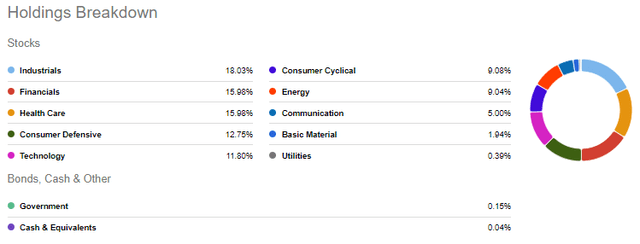Summary
- Charlie Munger has emphasized the importance of investing $100,000 as a first step toward achieving financial freedom.
- Warren Buffett has highlighted the need to generate passive income to avoid working until death.
- We explain why SCHD is a strong investment option for reaching financial freedom in-line with the investing wisdom of Munger and Buffett.

anilakkus/iStock via Getty Images
Charlie Munger once said that the first step to building long-term financial freedom is to accumulate $100,000:
The first $100,000 is a *****, but you gotta do it. I don't care what you have to do – if it means walking everywhere and not eating anything that wasn't purchased with a coupon, find a way to get your hands on $100,000.
Moreover, his business partner at Berkshire Hathaway (BRK.A)(BRK.B) - Warren Buffett - emphasized the importance of building up passive income streams, stating:
If you don't find a way to make money while you sleep, you will work until you die.
The significance of reaching a $100,000 milestone in savings is due to the fact that it represents reaching a point where you have what typically represents several years' worth of living expenses and therefore are not too far away from compounding your savings to a point where you are generating passive income that equals or even exceeds your living expenses. Before reaching the $100,000 level, the growth of the investment portfolio is primarily driven by additional capital contributions and is therefore typically quite slow. After crossing this threshold, however, the earnings and growth from the investments themselves become significant contributors to portfolio growth. This shift allows for faster accumulation of wealth without needing to proportionately increase personal capital contributions.
Moreover, having $100,000 invested also represents that the investor has been saving for long enough and/or is earning a large enough salary that they are highly likely to be a consistent saver and investor moving forward. As with just about anything, consistency is key for long-term success. In fact, in the area of investing, consistency is even more important than normal because the wild swings of the market often mess with investors' emotions, prompting them to invest extremely aggressively during bull markets and under-invest or even sell during bear markets, resulting in an above-average cost basis and subpar long-term total returns.
Turning $100,000 into a passive income stream that provides financial freedom requires a strategic approach that involves not just saving, but also investing wisely. This involves selecting the right mix of assets that offer a balance of growth and income and continuously reinvesting earnings to take advantage of the magic of compounding. As your portfolio grows, it becomes important to maintain appropriate diversification to mitigate risks and ensure that the portfolio can withstand market fluctuations and continue growing over the long term. Consistent investing over many years, even in small amounts, when coupled with proper diversification and risk mitigation to avoid major permanent portfolio setbacks, can lead to significant wealth accumulation due to the exponential nature of compound growth. Once an investor reaches the $100,000 milestone, the focus can shift more toward managing and growing the existing capital rather than merely aggressively adding to it. The passive income generated from a portfolio of this size can be substantial, reducing the need for active income and allowing for more financial freedom and flexibility.
In this article, we will look at several reasons why the Schwab U.S. Dividend Equity ETF (NYSEARCA:SCHD) stands out as a particularly effective vehicle for going from $100,000 to financial freedom.
#1. Powerful Dividend Growth
SCHD stands out for its strong dividend growth track record, with a dividend per share CAGR of 13.90% from 2012-2022, from a payout amount of $0.8717 in 2012 to $2.5615 in 2022. Moreover, when we look at the dividend growth track records of its top holdings of the moment, we see that it appears well positioned to continue this strong dividend growth momentum. For example, Verizon Communications Inc. (VZ) boasts a 19-year dividend growth streak, Coca-Cola Co. (KO) has a 61-year dividend growth streak, PepsiCo Inc. (PEP) has a 51-year dividend growth streak, Home Depot Inc. (HD) has a 14-year dividend growth streak, Amgen Inc. (AMGN) has a 12-year dividend growth streak, and Broadcom Inc. (AVGO) has a 12-year dividend growth streak.
#2. Sufficiently Strong Starting Dividend Yield
While dividend growth - especially of the double-digit CAGR variety that SCHD has historically generated - is certainly a very important and powerful contributor to achieving financial freedom from a starting principal of $100,000, having a sufficiently strong starting dividend yield is also very important.
Here is a chart that illustrates this principle quite clearly (note that this does not even include reinvesting dividends, which makes the differential in required CAGRs between the starting dividend yields even starker):
| Starting Dividend Yield | 10-Year CAGR to achieve a 7% Yield on Cost |
| 1% | 21.48% |
| 1.5% | 16.65% |
| 2% | 13.35% |
| 2.5% | 10.84% |
| 3% | 8.84% |
| 3.5% | 7.18% |
| 4% | 5.76% |
| 4.5% | 4.52% |
| 5% | 3.42% |
| 5.5% | 2.44% |
| 6% | 1.55% |
It is obvious that lower initial dividend yields necessitate faster growth rates, while higher initial dividend yields can achieve the same future Yield on Cost with more modest growth rates. However, what is intriguing is that the relationship between the starting yield and the required dividend growth rate is exponential.
Given that SCHD has a starting TTM yield of 3.7%, it sits in a much better position than many other popular ETFs. For example, the SPDR S&P 500 ETF Trust (SPY) has a starting yield of just 1.44%, the Invesco QQQ Trust ETF (QQQ) has a starting yield of just 0.56%, and the Vanguard Dividend Appreciation Index Fund ETF (VIG) has a starting yield of just 1.95%. When you combine this with SCHD's very strong dividend growth rate, the path to achieving a very high yield on cost in a reasonable amount of time is quite clear.
#3. Low Long-Term Risk
In addition to its powerful combination of current yield and dividend growth, SCHD rounds out its credentials as a powerful passive income investment vehicle with its relatively low-risk structure. First and foremost, it has one of the lowest expense ratios in the entire ETF universe at a mere 0.06%. This makes it a Buffett-like investment vehicle given the Oracle of Omaha's past comment about fund fees:
Performance comes, performance goes. Fees never falter
This means that investors will lose relatively little of their investment profits over the long term, reducing the risk of underperformance and/or lackluster dividend growth over time. Additionally, SCHD holds 104 individual stocks in its portfolio right now that are well-diversified across numerous major sectors of the economy:

Seeking Alpha
As a result, it should be able to sustain pretty solid dividend growth through various ebbs and flows of technological disruption and macroeconomic conditions as various portions of its portfolio will perform better than others in a wide range of scenarios. Moreover, it is well insulated against individual company risk given that it is well diversified across so many companies.
Investor Takeaway: Putting It All Together
According to Charlie Munger, reaching the $100,000 savings milestone is a significant stepping stone towards financial freedom, because it represents the approximate point at which the dynamics of investment growth shift from being contribution-led to earnings-led. For those looking to incorporate this principle into their own portfolios with an emphasis on substantial, growing, and reliable passive income - in line with Mr. Buffett's admonition to "make money while you sleep" - SCHD is a great option for a portfolio's foundation.
While it is probably not a complete portfolio solution, its impressive dividend growth track record, solid starting dividend yield, and low long-term risk profile make it an attractive option for many retail investors, especially those looking for a more passive approach.
Comments